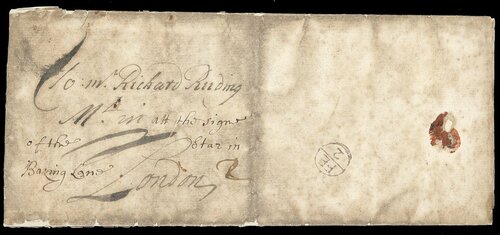
Auction: 20041 - The "Dubois" Collection of Jamaica Postal History and Stamps - Part I - conducted behind closed doors
Lot: 7
The Catastrophic Earthquake of June 1692 and the destruction of Port Royal
The Remarkable First Hand Account by James Wale at Port Morant
1692 (June) entire letter from James Wale, first British appointed Deputy Postmaster of Jamaica, to his cousin "Mr. Richard Ruding in London", and in another hand, "at the sign of the Star in Basing Lane", rated "2" from arrival port to London and with "
Note: Two-thirds of the town, amounting to 33 acres, sank into the sea immediately after the main shock. According to Robert Renny in his 'An History of Jamaica' (1807): "All the wharves sunk at once, and in the space of two minutes, nine-tenths of the city were covered with water, which was raised to such a height, that it entered the uppermost rooms of the few houses which were left standing. The tops of the highest houses were visible in the water and surrounded by the masts of vessels, which had been sunk along with them."
Before the earthquake the town consisted of 6,500 inhabitants living in about 2,000 buildings, many constructed of brick and with more than one storey, and all built on loose sand. During the shaking, the sand liquefied and the buildings, along with their occupants, appeared to flow into the sea. More than twenty ships moored in the harbour were capsized. One ship, the frigate Swann, was carried over the rooftops by the tsunami. During the mainshock, the sand was said to have formed waves. Fissures repeatedly opened and closed crushing many people. After the shaking stopped the sand again solidified, trapping many victims.
At Liguanea (presently Kingston), all the houses were destroyed and water was ejected from 40-foot-deep (12m.) wells. Almost all the houses at St. Jago (Spanish Town) were also destroyed.
There were many landslides throughout the island. The largest, the Judgement Cliff landslide, displaced the land surface by up to 800m. and killed 19 people. Several rivers were temporarily dammed and a few days after the earthquakes the harbour became flooded with large numbers of trees stripped of their bark brought down after one of these dams was breached.
A pocket watch, made in the Netherlands by the French maker Blondel in about 1686, was recovered during underwater archaeological investigations led by Edwin Link in 1959. The watch was stopped with its hands pointing to 11:43; this matches well with contemporary accounts of the timing of the earthquake.
Even before the destruction was complete, some of the survivors began looting, breaking into homes and warehouses. The dead were also robbed and stripped, and, in some cases, had fingers cut off to remove the rings that they wore.
In the immediate aftermath of the earthquake, it was common to ascribe the destruction to divine retribution on the people of Port Royal for their sinful ways. Members of the Jamaica Council declared: "We are become by this an instance of God Almighty's severe judgement." This view of the disaster was not confined to Jamaica; in Boston, the Reverend Cotton Mather said in a letter to his uncle: "Behold, an accident speaking to all our English America."
After the earthquake, the town was partially rebuilt though the colonial government was relocated to Spanish Town, which had been the capital under Spanish rule. Port Royal was devastated by a fire in 1703 and a hurricane in 1722. Most of the sea trade moved to Kingston. By the late 18th century, Port Royal was largely abandoned
Sidney Raine
Sissons, December 1982
Subject to 20% VAT on Buyer’s Premium. For more information please view Terms and Conditions for Buyers.
Estimate
£8,000 to £10,000
Starting price
£6500




